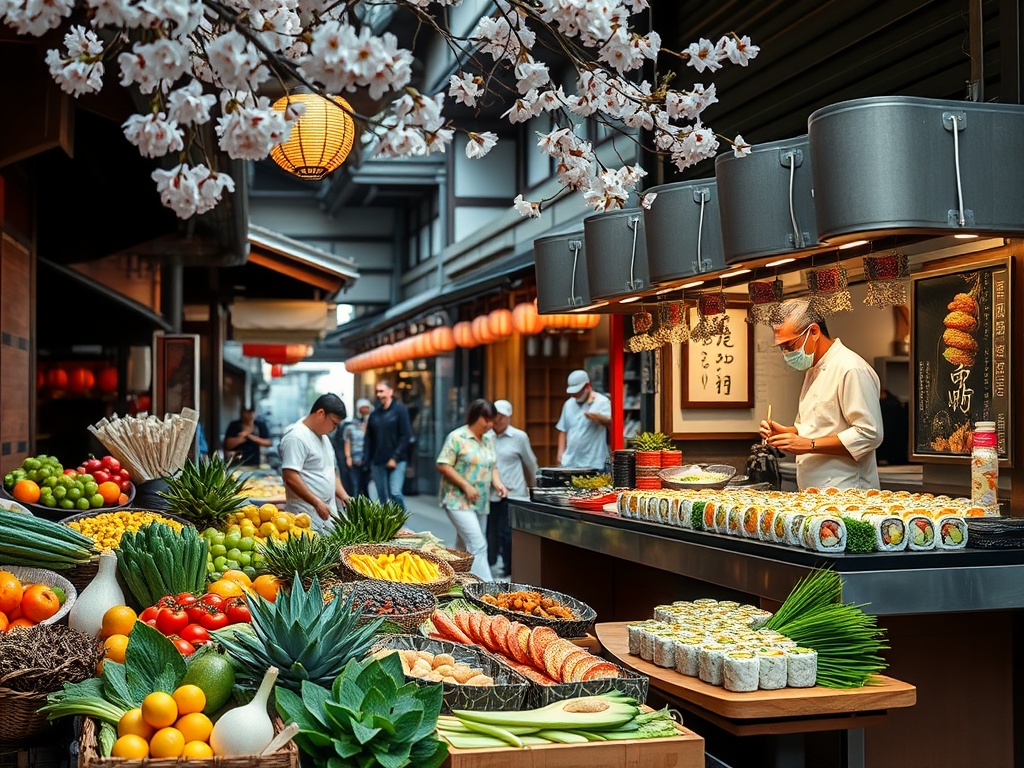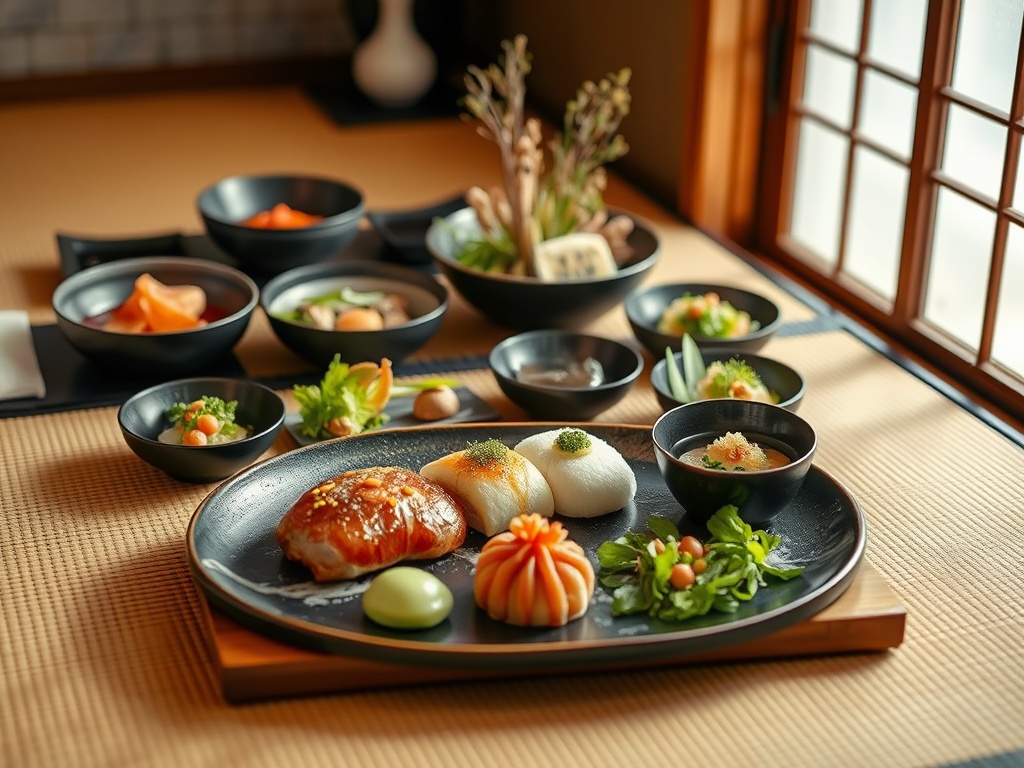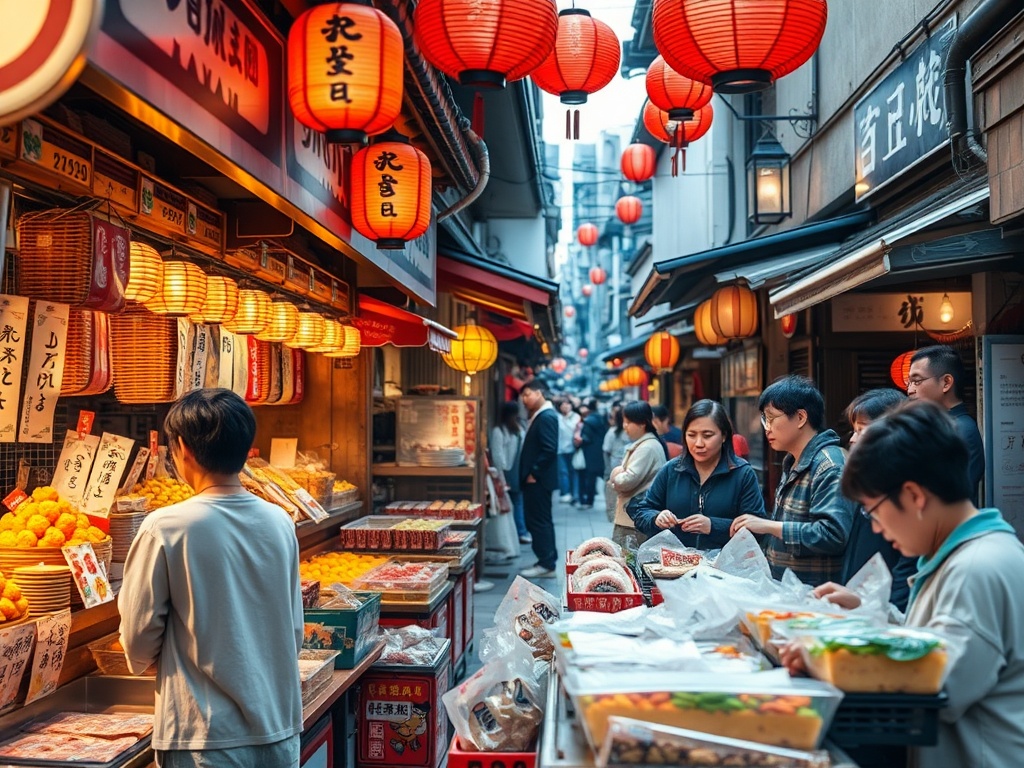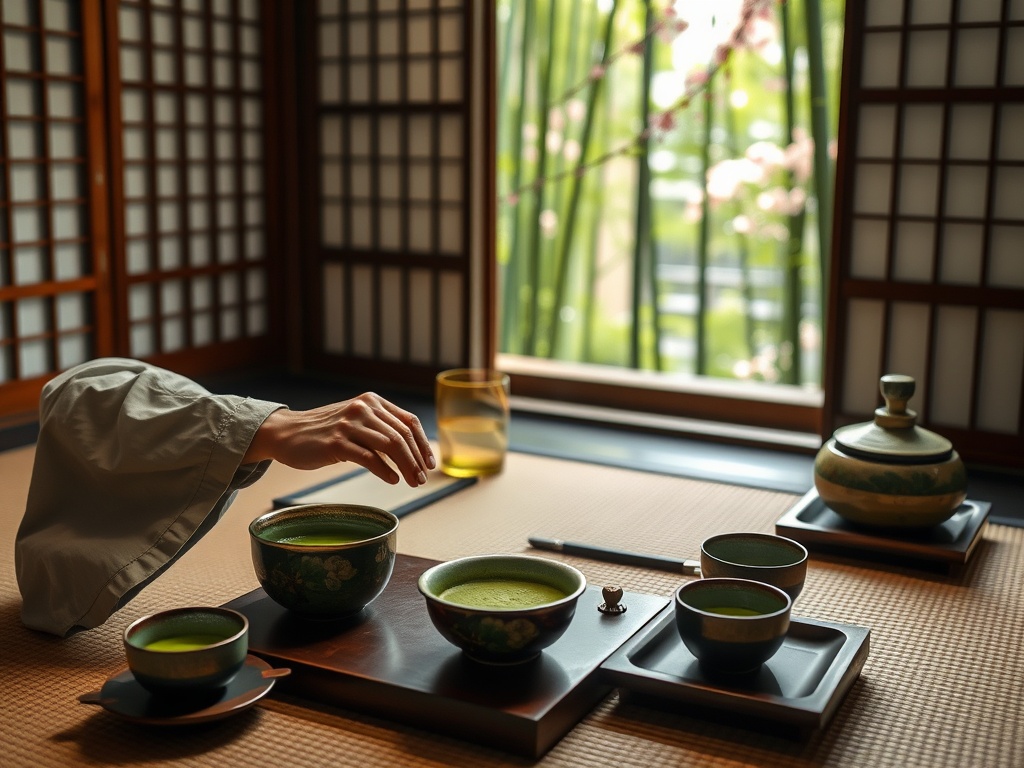Savoring the Seasons: Kyoto’s Kyo-Kaiseki Experience
Win a Free Trip to Japan!
Experience cherry blossoms and ancient temples
Kyoto, the cultural heart of Japan, offers an unparalleled culinary journey where every dish tells a story of the seasons. The exquisite art of kyo-kaiseki dining is a testimony to the region’s dedication to tradition and innovation. This multi-course meal not only highlights the freshest local ingredients but also celebrates the aesthetic presentation, making each serving a feast for both the eyes and the palate.
At the center of Kyoto’s gastronomic allure lies kyo-kaiseki, a culinary practice that has been honed over centuries. This experience is more than just dining; it is a ritual that honors the seasonality of ingredients. Each course is meticulously crafted to reflect the time of year, emphasizing a balance of taste, texture, and appearance. Renowned chefs in Kyoto strive to achieve harmony by blending traditional recipes with contemporary touches, ensuring that every meal is a unique masterpiece.
While each kyo-kaiseki meal is unique, certain dishes are pivotal in conveying the authenticity of Kyoto’s culinary heritage. Here’s a list of must-try dishes that encapsulate the essence of kyo-kaiseki:
- Sakizuke – The appetizer that sets the tone for the meal, often featuring seasonal vegetables or seafood.
- Mukozuke – A sashimi course that showcases the freshest catch, delicately sliced to perfection.
- Takiawase – A harmonious blend of vegetables, meat, or tofu, each ingredient prepared separately and served together.
- Yakimono – Grilled dishes, usually fish, that are lightly seasoned to highlight natural flavors.
For those eager to indulge in authentic kyo-kaiseki, Kyoto offers a plethora of esteemed establishments that promise a memorable dining experience. From historical tea houses to modern culinary sanctuaries, each location offers a unique interpretation of this cherished tradition. Embrace the opportunity to dine at renowned restaurants such as Gion Karyo or Hyotei, where the art of kyo-kaiseki is elevated to new heights.
Street Food Adventures: From Nishiki Market to Hidden Alleyways
Kyoto, a city where ancient tradition meets cutting-edge innovation, offers a street food scene that is as vibrant as it is diverse. Meandering through the bustling lanes and serene alleyways, travelers are greeted with an array of culinary delights that invite exploration. From the iconic Nishiki Market to the city’s lesser-known nooks, street food in Kyoto is a tapestry of flavors that reflects the city’s rich cultural heritage and contemporary creativity.
Known as Kyoto’s Kitchen, Nishiki Market is a must-visit for food lovers seeking an authentic taste of Kyoto’s street food offerings. This lively market, with its colorful stalls, offers an enticing array of snacks that showcase the region’s agricultural bounty. Visitors can savor the likes of fresh yuba (tofu skin), grilled ayuyaki sweetfish, and aromatic hojicha tea. Each bite at Nishiki Market is a celebration of Kyoto’s seasonality and craftsmanship, offering a sensory journey that captivates both the novice and seasoned traveler.
Beyond the well-trodden paths of the market, Kyoto’s hidden alleyways offer a treasure trove of street food gems waiting to be discovered. These secluded spots, often overlooked by the untrained eye, are where locals indulge in their favorite bites. Stumble upon stalls serving takoyaki – crispy octopus balls, or the savory delight of okonomiyaki – a Japanese pancake filled with a variety of ingredients. The charm of these alleyway eateries lies in their ability to offer a slice of local life, where tradition and modernity coexist in delicious harmony.
Tea Time Traditions: Unveiling the Art of Kyoto’s Matcha Culture
Kyoto, a city that embodies the essence of Japan’s cultural heritage, offers a matcha experience unlike any other. The art of matcha, a finely ground green tea, is deeply intertwined with the city’s history and aesthetics. Travelers venturing into Kyoto’s tea culture are not merely tasting a beverage; they are engaging in a ritual that has been perfected over centuries. This journey into the world of matcha reveals a blend of tradition, mindfulness, and an appreciation for the subtle nuances of flavor.
At the heart of Kyoto’s matcha culture is the traditional tea ceremony, a practice that dates back to the 15th century. This ceremony, known as ‘chanoyu,’ is a meditative art form that emphasizes harmony, respect, purity, and tranquility. Visitors are often invited to participate in these ceremonies, where they can witness the meticulous preparation of matcha. From the precise whisking of the green powder to the delicate presentation, each element is curated to create an atmosphere of calm and reflection. The ceremony is not just about consuming tea; it is about savoring the moment and the company of those present.
For those seeking a more contemporary matcha experience, Kyoto’s vibrant matcha cafes offer a delightful fusion of tradition and modernity. These establishments, scattered throughout the city, provide an array of matcha-infused delights that cater to both purists and adventurers alike. Whether it’s a creamy matcha latte or a delicate matcha parfait, the cafes in Kyoto are constantly pushing the boundaries of creativity. Each sip or bite is a testament to the versatility of matcha, with its distinct umami flavor and vibrant green hue captivating locals and tourists alike.
The historic district of Gion is particularly renowned for its charming tea houses where visitors can enjoy a serene afternoon indulging in matcha delicacies amidst the echoes of traditional Kyoto. These cafes not only highlight the versatility of matcha as an ingredient but also serve as a sanctuary for those looking to escape the city’s hustle and bustle. They provide a perfect setting to unwind and reflect on the experiences gained while exploring Kyoto’s rich culinary scene.
Fusion Flavors: Where Modern Culinary Arts Meet Ancient Techniques
Kyoto’s culinary landscape is a captivating fusion of the old and the new, where traditional techniques are skillfully blended with modern culinary arts to create unique dining experiences. This harmonious marriage of flavors not only respects the city’s rich heritage but also invites innovation, offering travelers a taste of Kyoto’s evolving identity. Explore a world where chefs draw inspiration from the past while embracing the future, crafting dishes that are both familiar and refreshingly new.
In the heart of Kyoto, visionary chefs are redefining what it means to dine in this historic city. By integrating international influences and contemporary cooking methods, these culinary artists are revolutionizing the local food scene. From molecular gastronomy to creative plating, every dish is an exploration of flavor and form. A visit to Kyoto is incomplete without experiencing the culinary creativity of these chefs, who are not just preserving tradition but breathing new life into it.
Kyoto’s dining establishments offer a window into the city’s culinary evolution. The following list highlights some must-visit fusion restaurants that epitomize the blend of modern and traditional:
- Giro Giro Hitoshina: Known for its avant-garde take on kaiseki, this restaurant presents a dynamic menu that changes monthly, reflecting both seasonal ingredients and contemporary flair.
- Oagari: A hidden gem in the Gion district, Oagari delights guests with its inventive dishes that pair classic Japanese elements with Western techniques.
- Nishiki Warai: Set within the bustling Nishiki Market, this eatery offers a playful twist on Kyoto specialties, infusing them with unexpected global flavors.
For Kyoto’s chefs, the challenge lies in maintaining a delicate balance between honoring traditional culinary practices and embracing modernity. This balance is achieved through a deep understanding of local ingredients and time-honored techniques, woven seamlessly with contemporary cooking styles. The result is a vibrant tapestry of flavors that respects the past while looking boldly to the future.
Temple Dining: Spiritual and Gastronomic Journeys in Kyoto
In Kyoto, the culinary experience extends beyond the bustling markets and contemporary cafes, reaching into the serene and sacred spaces of its many temples. Here, dining becomes a meditative journey, blending spirituality with gastronomy in a uniquely Kyoto fashion. Temple dining, often referred to as shojin ryori, is a centuries-old vegetarian cuisine that reflects the principles of Zen Buddhism. This form of dining offers an opportunity to not only nourish the body but also to cultivate mindfulness and appreciation for the simplicity of life.
Shojin ryori, literally meaning ‘devotion cuisine’, is crafted with ingredients that are fresh, seasonal, and devoid of animal products. The philosophy behind this cuisine is rooted in the teachings of Buddhism, emphasizing respect for all living beings and a harmonious relationship with nature. This culinary practice is marked by its simplicity yet profound depth of flavor, derived from meticulous preparation and the thoughtful combination of ingredients.
- Key Elements of Shojin Ryori:
- Tofu and Soy Products: A rich source of protein, these are staples in shojin ryori dishes.
- Seasonal Vegetables: Fresh produce that aligns with the natural cycles of the year, bringing vibrant colors and flavors.
- Pickled Delights: Preserved vegetables that provide a burst of umami and enhance the meal’s complexity.
Kyoto is home to numerous temples where visitors can partake in this spiritual dining journey. These settings provide a tranquil backdrop, allowing diners to fully immerse themselves in the calming atmosphere that complements the meal. Notable temples such as Tenryu-ji and Nanzen-ji offer visitors a chance to enjoy shojin ryori in a setting that is both peaceful and inspiring. Each meal becomes a reflection of the temple’s dedication to the art of mindful living, offering an experience that is as enriching for the soul as it is for the palate.
Whether you are a seasoned foodie or a traveler seeking to connect with Kyoto’s cultural essence, temple dining offers a unique perspective on the city’s culinary landscape. It is an invitation to slow down, reflect, and savor the interconnectedness of food, tradition, and spirituality.
Crafting Perfection: The Rise of Kyoto’s Artisan Sake Breweries
In the heart of Japan’s cultural capital, Kyoto, sake breweries are experiencing a renaissance that merges time-honored techniques with modern innovation. The city, known for its rich history and culinary artistry, is now a burgeoning hub for sake production, attracting enthusiasts from around the world. These artisan breweries are redefining sake with a blend of tradition and creativity, offering an unparalleled tasting journey.
The essence of Kyoto sake lies in its meticulous crafting process, which is as much an art as it is a science. Sake, often referred to as ‘nihonshu’ in Japanese, is a rice-based alcoholic beverage that has been brewed in Japan for thousands of years. In Kyoto, the art of sake brewing has been elevated to new heights, with local brewers focusing on purity, precision, and passion. The region’s pristine water sources and high-quality rice varieties contribute to the distinctive characteristics of Kyoto’s sake, known for its refined flavor profiles and delicate aroma.
Kyoto’s artisan sake breweries are at the forefront of an exciting movement, combining age-old traditions with cutting-edge techniques. Many brewers are experimenting with unique fermentation processes and incorporating local ingredients, creating sake that resonates with both the past and the present. This fusion approach not only preserves the heritage of sake brewing but also introduces novel flavors that appeal to a global audience. Sake tasting in Kyoto offers a chance to explore the diverse range of products crafted by these visionary artisans, each bottle telling a story of innovation intertwined with history.



